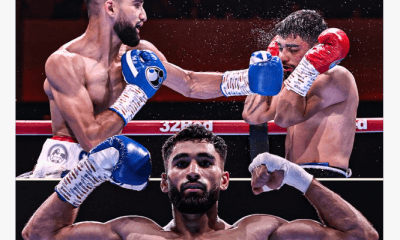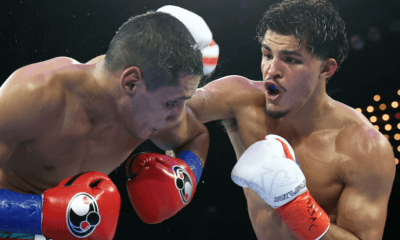Featured Articles
Brother Naazim’s Remarkable Life is Now a Wrap

Hall of Fame catcher Yogi Berra once noted that “you can see a lot of stuff by looking,” and part of the legend of Naazim Richardson, who passed away today at 56 after years of declining health, is his attention to even the most seemingly mundane of details, like the wrapping of a fighter’s hands.
Although Richardson’s place in his hometown of Philadelphia’s boxing annals was already secure, or mostly so, his national and global profile rose considerably the night of January 24, 2009, when he served, for the first time, as the chief second for “Sugar” Shane Mosley, who was 37 years of age and a 4-1 underdog heading into his challenge of WBA welterweight champion Antonio Margarito in Los Angeles’ Staples Center. Margarito was being hailed as one of the sport’s most devastating punchers after he had beaten the great Miguel Cotto bloody in winning by 11th-round stoppage six months earlier.
But in Margarito’s dressing room before the fight to observe the wrapping of his hands, a chore for which many untrained or disinterested state inspectors often give short shrift, Richardson spotted something that very well may have been a determining factor in the outcome, a rousing 11th-round TKO by Mosley. Officials for the California State Athletic Commission, alerted to the fact Margarito’s hand wraps were illegal (and may well have been for the Cotto fight and others, which might be why Margarito was suspended for one year by the CSAC), agreed that Richardson’s objection was valid. All of a sudden, Margarito’s’s vaunted power seemed less so with rewrapped hands, and after the seventh round, as Mosley continued to pound away at the Mexican, HBO blow-by-blow announcer Jim Lampley excitedly advised viewers that every big-name fighter considering a change in his corner would soon have Richardson’s phone number on speed-dial.
As was his wont, “Brother” Naazim, a devout Muslim disinclined to seek out the spotlight, refused to take much credit for his fighter’s bravura performance. Nor was everyone inclined to give him his due then; noted trainer Teddy Atlas even downplayed the hand-wraps issue, calling Richardson the “flavor of the month” in a business that is “fickle that way.”
The same scene played out earlier, on September 29, 2001, with Richardson serving as the assistant trainer under Bouie Fisher for Bernard Hopkins’ middleweight unification showdown with the favored Felix Trinidad in Madison Square Garden. Again in the opponent’s dressing room to observe the hand-wrapping, he pointed out a violation to inspectors for the New York State Athletic Commission who almost needed to be prodded into adhering to commission rules prohibiting “layering.” Hopkins then went out and dominated from the opening bell, scoring a dramatic 12th-round TKO, arguably the most impressive performance of his long career.
“If you put on tape, then gauze, then tape, then gauze, it’s like a (plaster) cast. Naazim did a brilliant job in spotting what (Felix Trinidad Sr.) was doing with the wraps,” Hopkins said in describing layering, which is in violation of rules that stipulate tape cannot be applied directly over the knuckles, and that the required 10 yards of gauze and two yards of tape must be applied in one winding.
Once again, the modest Richardson – who returned to his training duties after recovering from the stroke he suffered in 2008 — was disinclined to try to horn in on Hopkins’ moment of glory. “Bernard just didn’t get hit a lot,” he said. “If Trinidad had bricks in (his gloves), he still wouldn’t have beaten Bernard that night.”
A 2014 inductee into the Pennsylvania Boxing Hall of Fame, Richardson would move up from Hopkins’ assistant trainer to the top spot after B-Hop and Fisher had a falling out in 2006, being the primary voice in the corner for several more of the cagey veteran’s signature victories. In addition to his work with Hopkins and Mosley, a Californian, he also received kudos for the improvements made on his watch by another Philly guy, cruiserweight champion Steve “USS” Cunningham.
“He worked with some good fighters, and it was obvious they were all fundamentally sound,” Atlas, who came to regard Richardson as something more substantial than a flavor of the month, said upon hearing of his fellow trainer’s passing. “That’s the mark of a good trainer. He gave his fighters a base upon which to raise their skill level.”
John DiSanto, founder of Phillyboxinghistory.com, is a historian of Philadelphia boxing and he said that Richardson has earned his place alongside a great fight town’s most legendary trainers.
“Naazim will always be remembered as one of the best trainers to come out of Philly,” DiSanto said. “Just an amazing guy. There was nobody who liked to talk boxing more than him. If the conversation was about boxing, he’d just wear you out. He’d talk you under the table.
“The guy’s a legitimate star, and he’ll be greatly missed.”
But while Richardson is mostly known now for his association with world champions such as Hopkins, Mosley and Cunningham, he first began to draw attention as the father of a couple of eight-year-old phenoms, identical twins Rock and Tiger Allen, as well as Mike and Karl Dargan, whom he coached at the Concrete Jungle Gym in North Philadelphia.
As precocious grade-schoolers, the Allen twins drew attention for being able to crank out literally thousands of pushups and in tandem winning dozens of national tournaments. They were to have become as renowned and accomplished as was Hopkins, but a dark cloud arose at the 2000 U.S. Olympic Trials in Tampa when both twins were disqualified. Tiger was the only one of the 96 entrants to fail to make weight, coming in a whopping 4½ pounds over the 125-pound limit. Rock won his opening match in the 132-pound weight class, but the reigning U.S. national champion was disqualified when officials of USA Boxing determined that Tiger had attempted to weigh in in his stead, and signed paperwork indicating he was Rock.
Rock swallowed his disappointment and returned for the 2004 U.S. Olympic Trials, earning a spot on the American squad that competed in Athens, Greece, where he lost his first-round bout.
Upon turning pro, Rock, more dedicated to achieving his pro goals, was 15-0 with seven KOs as a rising welterweight prospect when he and Tiger, both 29, were both seriously injured in a one-vehicle crash on June 7, 2011. It weighed heavily on him that two young fighters he had defeated at the 2004 U.S. Olympic Trials, Lamont Peterson and Devon Alexander, went on to become world champions as pros.
“He’s seeing guys that he beat go on with their careers,” the father said in May 2013. “You don’t think it bothers him that he won’t – can’t – be where they are? It does, man. It hurts.”
Naazim Richardson’s passing closes the book on a chapter of Philadelphia boxing that, at varying turns, is both celebrated and controversial. But one thing is undeniable: when it came to anything related to the sport to which he devoted so much of his life, as DiSanto noted, Naazim Richardson definitely knew his stuff.
– – –
A New Orleans native, Bernard Fernandez retired in 2012 after a 43-year career as a newspaper sports writer, the last 28 years with the Philadelphia Daily News. A former five-term president of the Boxing Writers Association of America, Fernandez won the BWAA’s Nat Fleischer Award for Excellence in Boxing Journalism in 1998 and the Barney Nagler Award for Long and Meritorious Service in 2005. Last year, Fernandez was accorded the highest honor for a boxing writer when he was named to the International Boxing Hall of Fame with the class of 2020.
This past April 30, Fernandez’s memoir, “Championship Rounds,” was released by RKMA Publishing. For more information about “Championship Rounds” including where to purchase the book CLICK HERE.
Check out more boxing news on video at The Boxing Channel
To comment on this story in the Fight Forum CLICK HERE
-

 Featured Articles3 weeks ago
Featured Articles3 weeks agoResults and Recaps from New York Where Taylor Edged Serrano Once Again
-

 Featured Articles5 days ago
Featured Articles5 days agoThe Hauser Report: Zayas-Garcia, Pacquiao, Usyk, and the NYSAC
-

 Featured Articles3 weeks ago
Featured Articles3 weeks agoResults and Recaps from NYC where Hamzah Sheeraz was Spectacular
-

 Featured Articles4 weeks ago
Featured Articles4 weeks agoFrom a Sympathetic Figure to a Pariah: The Travails of Julio Cesar Chavez Jr
-

 Featured Articles2 weeks ago
Featured Articles2 weeks agoManny Pacquiao and Mario Barrios Fight to a Draw; Fundora stops Tim Tszyu
-

 Featured Articles3 weeks ago
Featured Articles3 weeks agoPhiladelphia Welterweight Gil Turner, a Phenom, Now Rests in an Unmarked Grave
-

 Featured Articles2 weeks ago
Featured Articles2 weeks agoArne’s Almanac: Pacquiao-Barrios Redux
-

 Featured Articles4 weeks ago
Featured Articles4 weeks agoCatterall vs Eubank Ends Prematurely; Catterall Wins a Technical Decision






















